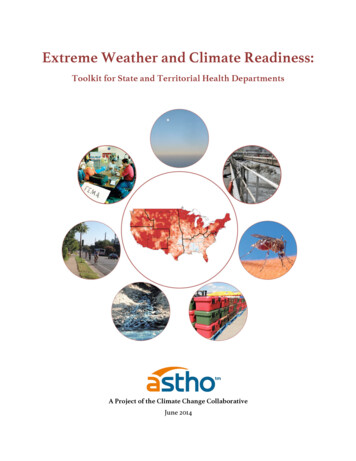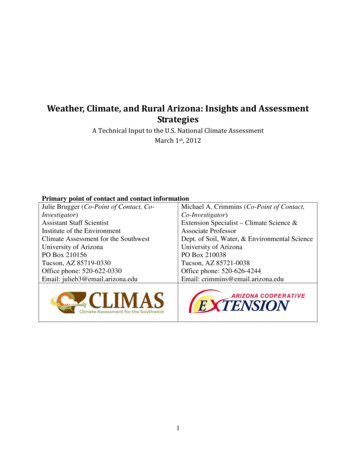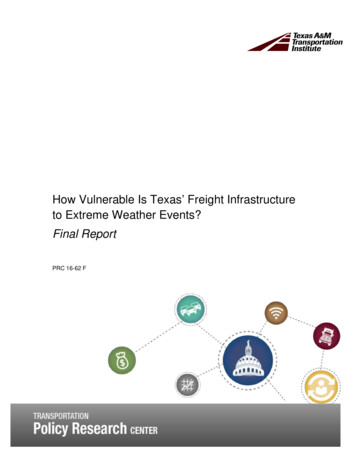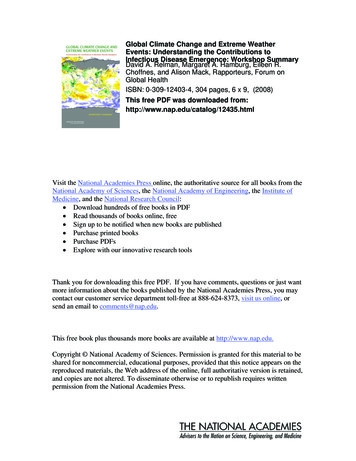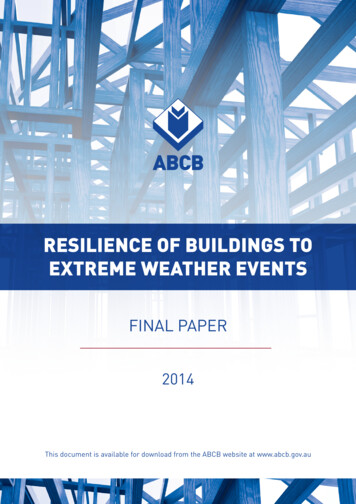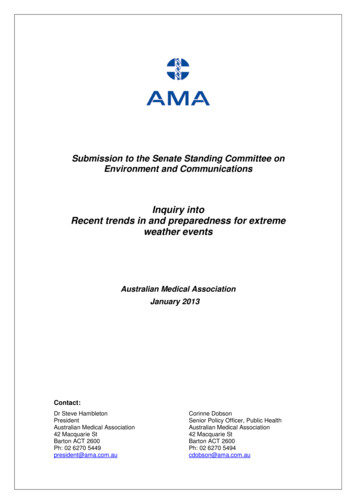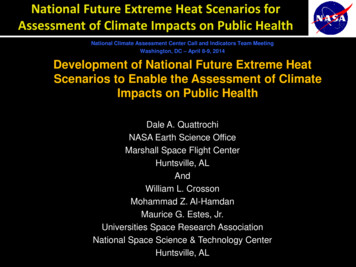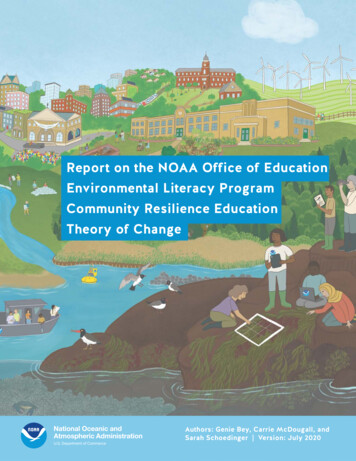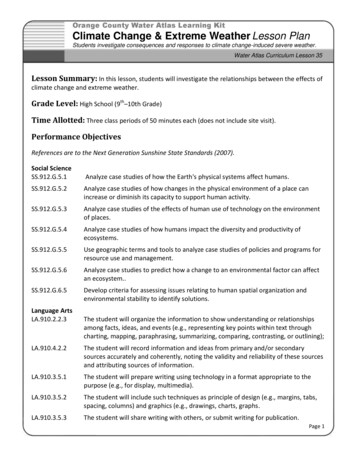
Transcription
Climate Change & Extreme Weather Lesson PlanStudents investigate consequences and responses to climate change-induced severe weather.Water Atlas Curriculum Lesson 35Lesson Summary: In this lesson, students will investigate the relationships between the effects ofclimate change and extreme weather.Grade Level: High School (9th–10th Grade)Time Allotted: Three class periods of 50 minutes each (does not include site visit).Performance ObjectivesReferences are to the Next Generation Sunshine State Standards (2007).Social ScienceSS.912.G.5.1Analyze case studies of how the Earth's physical systems affect humans.SS.912.G.5.2Analyze case studies of how changes in the physical environment of a place canincrease or diminish its capacity to support human activity.SS.912.G.5.3Analyze case studies of the effects of human use of technology on the environmentof places.SS.912.G.5.4Analyze case studies of how humans impact the diversity and productivity ofecosystems.SS.912.G.5.5Use geographic terms and tools to analyze case studies of policies and programs forresource use and management.SS.912.G.5.6Analyze case studies to predict how a change to an environmental factor can affectan ecosystem.SS.912.G.6.5Develop criteria for assessing issues relating to human spatial organization andenvironmental stability to identify solutions.Language ArtsLA.910.2.2.3The student will organize the information to show understanding or relationshipsamong facts, ideas, and events (e.g., representing key points within text throughcharting, mapping, paraphrasing, summarizing, comparing, contrasting, or outlining);LA.910.4.2.2The student will record information and ideas from primary and/or secondarysources accurately and coherently, noting the validity and reliability of these sourcesand attributing sources of information.LA.910.3.5.1The student will prepare writing using technology in a format appropriate to thepurpose (e.g., for display, multimedia).LA.910.3.5.2The student will include such techniques as principle of design (e.g., margins, tabs,spacing, columns) and graphics (e.g., drawings, charts, graphs.LA.910.3.5.3The student will share writing with others, or submit writing for publication.Page 1
Climate Change & Extreme Weather Lesson PlanStudents investigate consequences and responses to climate change-induced severe weather.Water Atlas Curriculum Lesson 35LA.910.4.2.2The student will record information and ideas from primary and/or secondarysources accurately and coherently, noting the validity and reliability of these sourcesand attributing sources of information;LA.910.4.2.3The student will write informational/expository essays that speculate on the causesand effects of a situation, establish the connection between the postulated causesor effects, offer evidence supporting the validity of the proposed causes or effects,and include introductory, body, and concluding paragraphs.LA.910.5.2.1The student will select and use appropriate listening strategies according to theintended purpose (e.g., solving problems, interpreting and evaluating the techniquesand intent of a presentation);LA.910.5.2.2The student will research and organize information for oral communicationappropriate for the occasion, audience, and purpose (e.g., digital presentations,charts, photos, primary sources, webcasts);LA.910.5.2.5The student will research and organize information that integrates appropriatemedia into presentations for oral communication (e.g., class discussions,entertaining, informative, persuasive, or technical presentations).Prior KnowledgeNo prior knowledge necessary.Topic OverviewHurricanes are the extreme weather example most often mentioned in conjunction with climatechange, but tornadoes, wildfires, droughts, floods, heat waves, and freezes can also threaten the wellbeing of central Florida residents. Students will investigate the potential effects of these events onbuilt and natural environments, commerce and society.Page 2
Climate Change & Extreme Weather Lesson PlanStudents investigate consequences and responses to climate change-induced severe weather.Water Atlas Curriculum Lesson 35Key VocabularyAtmosphereA band of gases enveloping the Earth's surface. Ninety-nine percent of its mass is concentratedwithin 20 miles of the earth’s surface, and its two largest constituents (in the lowest part) arenitrogen (about 78 percent) and oxygen (about 21 percent).BiospherePart of the Earth's surface and atmosphere that contains the entire terrestrial ecosystem, andextends from ocean depths to about six kilometers (3.7 miles) above sea level.Carbon dioxide (CO2)A colorless, odorless, poisonous gas resulting from fossil-fuel combustion and the breakdown oforganic matter.ClimateThe long-term average of conditions in the atmosphere, ocean, and ice sheets and sea icedescribed by statistics, such as means and extremes.Climate changeA change in the state of the climate that can be identified (e.g., by using statistical tests) byPage 3
Climate Change & Extreme Weather Lesson PlanStudents investigate consequences and responses to climate change-induced severe weather.Water Atlas Curriculum Lesson 35changes in the mean and/or the variability of its properties, and that persists for an extendedperiod, typically decades or longer. Climate change may be due to natural internal processes orexternal forces, or to persistent anthropogenic (human-caused) changes in the composition ofthe atmosphere or in land use.CryosphereThe component of the Earth's system that is frozen water, including snow, permafrost, floatingice, and glaciers. It is directly related to ocean sea-level, and therefore is indirectly related tochanges in the atmosphere and biosphere.DroughtAn extended period without rain: technically, a period in which rainfall is 70 percent belowaverage for three weeks or longer.GeosphereThe “solid” portion of the earth, including water masses; the lithosphere plus the hydrosphere.Above the geosphere lies the atmosphere and at the interface between these two regions isfound almost all of the biosphere, or zone of life.Global warmingA projected increase in the global mean temperature of as much as five degrees Fahrenheit thatmay occur by the end of the 21st century, caused by the increase in greenhouse gases that trapheat in the Earth's atmosphere.Greenhouse effectThe warming of the Earth's atmosphere that may be taking place, caused by the buildup ofcarbon dioxide and other gases in the atmosphere since the Industrial Revolution of the late1800s.Greenhouse gasesGases such as carbon dioxide, methane, chlorofluorocarbons, and nitrous oxides thataccumulate in the atmosphere and may be contributing to global warming.HydrosphereThe combined mass of water found on, under, and over the surface of the Earth. It includes allthe Earth's water found in the oceans, glaciers, streams, lakes, the soil, groundwater, and in theair.Sea-level riseThe rise in the world's oceans that may be occurring as a result of global warming.TemperatureThe temperature is a measure of the internal energy that a substance contains and is the mostmeasured quantity in the atmosphere.Page 4
Climate Change & Extreme Weather Lesson PlanStudents investigate consequences and responses to climate change-induced severe weather.Water Atlas Curriculum Lesson 35WeatherThe state of the atmosphere with respect to wind, temperature, cloudiness, moisture, pressure,etc. Weather refers to these conditions at a given point in time (e.g., today's high temperature).MaterialsComputers with Internet accessVideo camera (optional, for videos)Poster board, markers, paper, printer (optional, for poster sessions)ReferencesThese references can be found in the Orange County Water Atlas Digital Library:Borisova, Tatiana, Norman Breuer, and Roy Carriker. Economic Impacts of Climate Change on Florida:Estimates from Two Studies. 2008. University of Florida Institute of Food and Agricultural Sciences.Hurricanes Stronger Due to Warming. 2007. Environmental Defense Fund.Ekwurzel, Brenda. 2006. Hurricanes in a Warmer World, Union of Concerned Scientists.Hurricanes Unleashing Nature's Fury: A Preparedness Guide. 2001. National Weather Service.Global Warming and Extreme Weather: The Science, the Forecasts and the Impact on America.Environment America Research & Policy CenterMusil, Robert K., et al. 2001. Death By Degrees: The Health Threats of Climate Change in Florida.Physicians for Social Responsibility.Parkinson, Randall W. Adapting to Climate Change & Extreme Weather Events: A Florida Perspective.2009. Presentation to the Town of Melbourne Beach, FL.Robertson, Kevin. Wildfire, Prescribed Fire and Climate Change in Florida. 2007. Tallahassee, FL: TallTimbers Research Station.Sherin, Kevin M. 2010. Climate Change Adaptation Planning for Public Health in Orange County ,Florida. Orange County Department of Public Health.Other references:A Student's Guide to Climate Change. Website. Environmental Protection Agency. Accessed June 2011.Cook, John. Skeptical Science: Getting Skeptical About Global Warming Skepticism. Website. AccessedJune 2011.Intergovernmental Panel on Climate Change. Website. Accessed June 2011.Stanton, Elizabeth K., and Frank Ackerman. Florida and Climate Change: The Cost of Inaction. 2007.Tufts University Global Development and Environment Institute and Stockholm EnvironmentInstitute—US Center.Page 5
Climate Change & Extreme Weather Lesson PlanStudents investigate consequences and responses to climate change-induced severe weather.Water Atlas Curriculum Lesson 35ProcedureEngage/ElicitAsk students: What do we mean when we use the term “weather”? What do we mean whenwe use the term “climate”? What is the difference between the two?Tell students: Some have said that a better term for “climate change” might be “climatedisruption,” because weather patterns will become more erratic, rather than gradually andpredictably changing in a particular direction. In particular, scientists predict that the warmingof the earth’s atmosphere will lead to more frequent and more extreme weather events.Ask students: What kind of extreme weather events might we experience here? Make a list onthe board. Possible answers: hurricanes, tornadoes, drought, flood, wildfire, frost/extremelycold weather, heat waves.ExploreForm students into groups of 3-4 students. Ask each group to choose one of the types of extremeweather on the list, and to investigate its implications. Have each group choose a different type ofevent, if possible. Tell students that their group is to identify sources, perform research, and report on:1. How climate change would cause the intensity or frequency of these events to increase2. Impacts of the event and ways they might be reduced, related to:a. Human safetyb. Infrastructure (homes, businesses, transportation, utilities, etc.)c. Agriculture (farming, forestry, horticulture, aquaculture)d. Commerce (tourism, real estate/development,e. Ecosystems and wildlifef. Natural resource consumption (energy, water, food)g. Some other area of impact identified by the studentsThe group should work together to address question #1. For question #2, each student in the groupshould choose a different area of impact and conduct a very thorough investigation of it.ExplainStudents in each group should combine their research results and produce a presentation about theextreme weather event they chose. Depending upon the technology available to your students youmay wish to have them produce a poster presentation or a video. Give students a time limit for theirpresentation, taking into account the number of groups in your class and the time you have available.Posters: Display these in class and all students given a chance to peruse them for a fewminutes. Then, each group should present their poster to the class, with each student brieflysummarizing his or her individual findings.Page 6
Climate Change & Extreme Weather Lesson PlanStudents investigate consequences and responses to climate change-induced severe weather.Water Atlas Curriculum Lesson 35Video: These can be played in class or posted on social media (YouTube, Vimeo, etc.) forstudents to view at their leisure, prior to class. If the latter, more class time can be devoted todiscussion of the information presented.After each group finishes, if there is time, allow the class to ask questions. You may wish to have theclass vote on which group did the best presentation.ExtendPlan a class visit to the Orlando Science Center’s Severe Weather Center. Have students post their fieldtrip reports as stories on the Orlando Science Center’s page on the Orange County WatershedExcursion.Exchange/EvaluateHave students interview several friends or relatives who have experienced a hurricane or otherextreme weather event and prepare a “Lessons Learned” report. What preparations did their interviewsubjects take before the event to protect their safety and their property? What negative effects didthey suffer, if any? What advice would they give to others in a similar situation? What would they dodifferently in preparing for future events? Have students share their reports with the class.Curriculum developed for Orange County Environmental Protection Division by USF’s Florida Center for Community Design &Research. This material is based upon work supported by the Department of Energy under Award Number DE-EE0000791.This report was prepared as an account of work sponsored by an agency of the United States Government. Neither the United StatesGovernment nor any agency thereof, nor any of their employees, makes any warranty, express or implied, or assumes any legalliability or responsibility for the accuracy, completeness, or usefulness of any information, apparatus, product, or process disclosed, orrepresents that its use would not infringe privately owned rights. Reference herein to any specific commercial product, process, orservice by trade name, trademark, manufacturer, or otherwise does not necessarily constitute or imply its endorsement,recommendation, or favoring by the United States Government or any agency thereof. The views and opinions of authors expressedherein do not necessarily state or reflect those of the United States Government or any agency thereof.Page 7
Climate Change & Extreme Weather Lesson Plan . SS.912.G.5.5 Use geographic terms and tools to analyze case studies of policies and programs for . A Preparedness Guide. 2001. National Weather Service. Global Warming and Extreme Weather: The Science, the Forecasts and the Impact on

